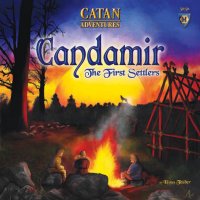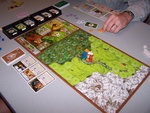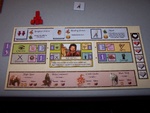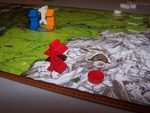
|
Candamir: The First Settlers A game by Klaus Teuber Published by Mayfair Games, Inc. and Kosmos Players: 2-4 Time: 60-120 minutes Reviewed by Susan Rozmiarek |
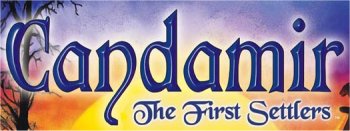
|
Candamir: The First Settlers is the first game in the new "Catan Adventures" series by Klaus Teuber. I was rather surprised to find that this game is not just another variation of the familiar Settlers of Catan series. Other than the setting, it only shares a few characteristics with Settlers and instead takes the game play in a totally new direction. Candamir is more of an exploration and adventure game where players build up their individual characters as they explore the board collecting things and encountering challenges.
Components:
The components are the usual top-notch quality I've come to expect with a Mayfair/Kosmos game.
The box includes a nice insert to hold everything.
All counters and tiles are of heavy stock and the cards are sturdy as well.
The Resource and Ingredient cards have separate removable inserts to hold them during the game.
This is a very nice touch.
The rulebook is well-written if not a little too detailed, and has plenty of color pictures and examples.
As with many of Teuber's other games, there is a nice online tutorial at
www.profeasy.com.
Game play:
The object of the game is to be the first player to earn 10 Victory Points.
Victory Points are achieved by exploring the island of Catan and finding the necessary resources to
supply goods needed by other settlers in the village.
Acquiring these resources will become easier as players gain experience in each of their four abilities:
Strength, Prowess, Agility and Charisma.
The game board depicting a village and the surrounding region is placed on the table. The Exploration Tiles are placed facedown randomly on the board in locations matching the terrain type (forest, grassland, or mountain) and number. All tiles will be used in a four player game, but only the number 2 and 3 tiles are used with three players and only the number 2 tiles are used with two players.
The Resource (ore, hide and lumber) and Ingredient (honey, herbs and mushrooms) Cards are sorted by type and put in their respective holders near the board. The Adventure Cards are shuffled and arranged in a deck with the cards numbered 1 on top, followed by the 2 cards and lastly, the 3 cards. The top three cards from this deck are turned over and placed in a row near the board. The movement cards are shuffled and placed facedown on the "Shuffle Cards" board. This deck will be passed around for each player to use on his turn.
Players receive a random Character Card, which is placed in the center of their Character Board. This card has the name of the character, a picture, the character's special abilities and the starting scores for each of the four abilities. The mix of scores and the abilities is unique for that character. The individual abilities include extra movement on certain terrain types and the ability to find hidden ingredients. As a nice touch, the game comes with both a male and a female version of each character so players can choose the gender.
Also on the player Character Board are spaces for players to put the potions they brew, Brigitta's Potions, Healing Potions, and Mead, as well as the ingredients needed to brew them and their effect for reference. There are spaces to assign experience points to each of the four abilities and spaces for equipment that also raise the scores. There is a column of hearts numbered from -1 to 4 to keep track of a character's health. Finally, there is a handy reference at the bottom of the Character Board that shows the rewards for success and the penalties for failure for various challenges the player may encounter. All-in-all the Character Boards are very nicely done, with a logical arrangement and convenient references.
Players also receive a set of wooden playing pieces in their color - an adventurer figure, 10 VP markers, and a Destination Marker. They also have a set of numbered experience markers and tiles that depict the different potions. At the start of the game, the adventurer figures are placed on the village square in the center of the board and each player receives one Brigitta's Potion to put on their Character Board, and a lumber card. During the game, Resource and Ingredient cards will be held in the player's hand and kept secret. Players also start with their health at "four" and place a marker on the heart track to reflect this.
Now the game is ready to begin. Players will either use their turn to explore the region OR they will stay in town and build and/or brew. Before they choose, however, they may trade resources, ingredients, potions, and/or equipment with other players. Or, they can trade resources and ingredients for 3:1 with the bank.
Exploration: A player may only choose this option if he has five or fewer ingredient cards and five or fewer resources cards, discarding down if he wants. To explore, a player secretly looks at any two Exploration Tiles on the board. He then puts his Destination Token on any tile on the board. He is now committed to reaching this tile before he can stop exploring and this tile is safe from other players.
The player may now move as many spaces orthogonally in any direction on his turn as he has health points. The mechanism for movement is really clever. For each space he moves, the player turns over a card from the Movement Deck and places it right side up before him. Each card has four arrows, one pointing to each of the four possible directions and the event or ingredient at that location (or nothing). The player chooses in which direction he wants to go, moves his figure and either collects the ingredient if he is under his hand limit or deals with the event. The events are usually things such as snakes, bears, and wolves, which require the player to test one of his abilities. He does this by rolling the die and adding his total score for that ability to the die roll. He may drink a Brigitta's potion to add a +2 to the roll. If he equals or beats the number on the Movement Card, he is successful and gets a reward. Failure usually results in a loss of health, although he still gets to move his figure into that space. Remember, health limits a player's movement, so it is very painful to lose it. A player can regain health by either drinking a Health Potion or skipping a turn. He now continues on by turning over a new Movement Card until he decides to stop or has used all his movement points.
A special event is an adventure. If a player chooses to go in this direction, he chooses an Adventure Card from the three face-up cards. These involve various tests, sometimes multiple ones, and rewards. Each card has flavor text that describes the adventure which we enjoyed taking the time to read aloud. New adventures are flipped up as they get completed and they get harder as the game progresses. Players keep completed adventures before them, as there is a 1 VP bonus for the player who completes the most.
If a player is able to reach his destination, he turns over the tile, receives the rewards depicted and immediately places his figure back in the village square. Exploration tiles have resources, animals, experience, equipment, or a combination. Resource cards go in a player's hand and in this case a player can go over his normal hand limit of five. If the tile shows an animal, the player immediately puts one of his VP cubes on an appropriate spot in a row in the village. The player assigns any experience shown to the abilitiy(s) of his choice. He is, however, limited to the set of experience tiles that he has. Note - he can only increase the experience of one ability past two. Explored tiles are removed form the game.
Building and Brewing: A player may choose this option if his figure is in the village square on the board.
The left hand side of the board is a close-up of the village which depicts the houses of four different settlers. Next to each house are one or two rows of different goods or animals desired by each of these settlers. These goods include swords, chests, window covers, cattle, and goats. The animals are found outright while exploring, but the other goods must be made from combinations of resources that are also found exploring. The cost in resources for each item is shown at the top of the board. To supply one of these goods, a player turns in the necessary collected resources from his hand and can then place one of his VP cubes on that good's spot on a row on the board. The catch is that the settlers want their goods in the order that they appear on the rows, so the good that you want to make must be the next available one on a row.
Across the bottom of the board are four bonus spots. Three of the settler's houses provide a bonus. The first player to supply three goods to one of these settlers gets to place an additional VP cube in the corresponding bonus box. There is also a bonus box for the first player to get three Adventure Cards. Another player may replace these bonus cubes with his own if he is able to provide more goods to that settler than the current bonus holder. This mechanism is similar to that of the "Longest Road" and "Largest Army" in Settlers of Catan. The fourth settler in the village, Brigitta, does not give a bonus but instead provides a potion and mead for every good a player provides for her.
The first player to place all 10 of his Victory Point cubes on the board is the winner.
Besides building goods, a player may also brew potions and mead while in the village. As in building, he simply turns in the necessary ingredient cards and places the appropriate tile on his character Board. A player may never have more than two of each type at a time, however.
A player may build and brew as much as he wants or is able if he chooses to build and/or brew on his turn.
There is one "take that" mechanism in the game which also helps in slowing down leaders. A player may, on his turn, drink one or two Mead (if he has them). All players who have the same or more Victory Points as that player must lose a health point for each Mead. I guess it's hard to travel quickly when you're drunk!
Comments:
I found Candamir to be an average game but nothing special the first few times I played it.
The games went much too long and there wasn't much trading between players.
I then discovered that there had been a printing error with the Exploration Tiles.
(You can read more about this problem in this BGG thread.)
The corrected tiles have more resources for the three and four player games.
This serves to correct both problems fairly well and I now find the game to be quite good.
It is a very "gentle" game which makes it especially suitable for playing with families.
There is only a little "take that" and players cannot be eliminated;
they merely must skip a turn to regain their health.
With plenty of little decisions to make each turn and different paths to victory,
the game has continued to hold my interest after several playings.
One downside to the game is the fact that there usually isn't a whole lot to do on your turn. Sure, there might be some trading with other players, but usually you are just waiting as there isn't much planning you can do. For this reason I enjoyed the two and three player games more than with four. There is also great deal of luck in the game with the turning over of tiles and Movement Cards, but it certainly fits the exploration theme and I rather enjoyed the uncertainty. Also, one of the characters, Rutild/Ansgar, seems a little bit weaker than the others. I never played with that character myself, but there was some whining from the players that did.
If you are a fan of adventure/exploration games, I can wholeheartedly recommend Candamir: The First Settlers. The Catan theme is a refreshing change from the common fantasy theme in similar games such as Runebound, and it has some clever mechanisms along with a few familiar ones. However, if you like games with lots of player interaction and confrontation, then this game probably isn't for you. I found it to be quite enjoyable and a nice break from some of the more intense games that I play.
| Other Web information: |
This page viewed
E-mail Ed Rozmiarek with questions or problems concerning this page.
Copyright © 2005, Ed & Susan Rozmiarek. No portion of this website may be reproduced or copied without the consent of Ed or Susan Rozmiarek.
